Mounting a Scope on a CZ 527 American

The CZ 527 American is gaining a reputation as a close-to-ideal "walk-around" varmint gun.
There are times when you may not want the long, heavy barrel and bulky bench-type stock of a specialty "varmint gun". In our neck of the woods, we have various types of ground squirrels that prefer the semi-concealment of more brushy areas, such as logging clearcuts and semi-brushy hillsides. Setting up a "shooting position" a couple hundred yards away is not only unnecessary, it is also impractical because of the abundant ground-hugging brush in the area.
It's a heck of a lot more fun to just walk around with an easy-to-carry rifle and pick 'em off as you find 'em. Ground squirrels are not known for stellar intelligence and will oftentimes pop up right in front of you, chirping and screeching at you. Ranges are sometimes surprisingly short. In this type of circumstance, a heavy-barrel 22-250 is just not the right type of gun - not to mention caliber - ever seen an 8-ounce ground squirrel hit with a 22-250 at 10 yards??
The 527 American is available in .223, .222, and .22 Hornet. The .223 is probably ideal for called-in coyote. At these ranges, .223 is all the cartridge you will ever need on even the biggest 'yote. On smaller animals such as squirrels, and even rockchuck, .223 is a bit on the powerful side, even when using full metal jacket ammo.
The 222 Remington is a great old cartridge with a solid reputation for accuracy, and very pleasant to shoot. It occupies its own power-level niche, and is regarded by many as the perfect power level for the caliber, at medium-close to medium-long ranges. From rockchuck and woodchuck on the bottom, through racoons, to called-in coyote at the top, the 222 Remington is considered by many to be the ideal cartridge for a walk-around varmint gun. And some say you couldn't find a better Bobcat gun if you tried.
If, like me, all you're after are the smaller critters, 22 Hornet is about as good as it gets. With explosive performance on ground squirrels, "lights out" one-shot stops on Fox without blowing the furs to smithereens, and solid performance on 'chucks and 'coons, the 22 Hornet is a real pussycat. Speaking of cats, it could be used on Bobcat with careful shot placement, but is more than a bit light for most coyote work.
The choice of scopes can be narrowed down to the shorter-range models. There is little need for a big, long, heavy, and powerful scope at these ranges - which is a good thing, since the 527 American is not exactly big-scope friendly (more on that later). A standard size 3-9x40 is about as big as you want to go (if you can make it fit), but the smaller models are probably a better match.
My first attempt at mounting a scope was with a Leupold VXII 2-7X33. The 527 comes with scope rings so I thought it would be a fairly straightforward installation. It went on OK, but I had trouble getting my eye far enough back to get a good sight picture. Eventually, I ended up jamming the scope all the way forward in the rings:
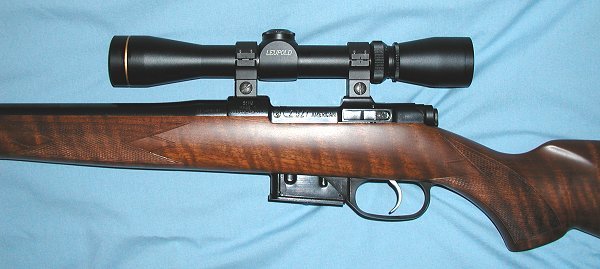
It seemed to work OK, but I still found myself wanting to back off from the most comfortable cheek weld in order to get the sight picture right. And I didn't like the way it looked - it always looks out of place to me to have a scope jammed as far forward (or back) as it will go in the rings. The ones that look the best seem to be the ones where the scope is mounted in the center of the rings. It's not a big deal, since this is almost never the case - in my experience, it's a rare situation when the best position of the scope for sight picture ends up being centered in the rings. Most scopes end up forward or backward of center, which is no big deal at all - it's only when parts of the scope are jammed up right against the rings that it looks really out of place.
So on to attempt number two - this time with a Burris 3-9X40 FullField II. I have no pictures from that install attempt because I never got it installed. The parts on the back of the scope are too big for the gun - I could find no way to get the scope installed and still be able to turn the power ring through its full range. So attempt number two was abandoned.
The cause of all this is a simple one: The CZ527 American is a relatively small rifle. Even though the length-of-pull is similar to other rifles, the receiver - and therefore the mounting area for the scope rings - is way further back on this rifle than on a standard rifle. Look at the picture below. This is a comparison with a Ruger Standard Rifle. The end of the buttstocks are in line with each other, but the scope rings on the CZ are way further back toward your face, than the scope rings on the Ruger:
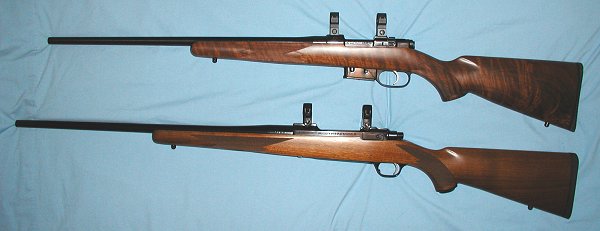
Here's a close-up to really show the difference:
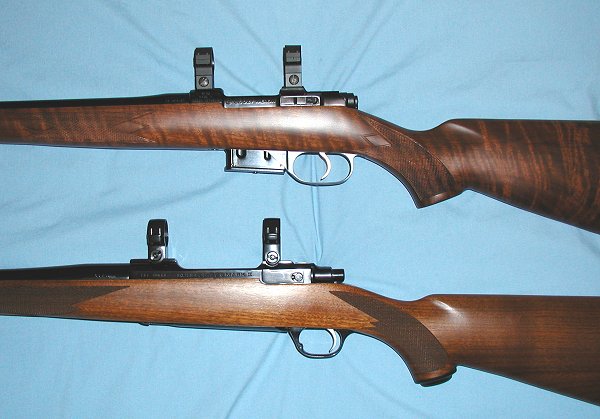
Here's another example. On top is the CZ with the Leupold 2-7X33. On the bottom is a Winchester Model 70 Classic Featherweight with a Leupold 2.5-8X36. The Featherweight is known as a compact rifle, but you are able to mount a scope quite a bit further forward than the CZ:
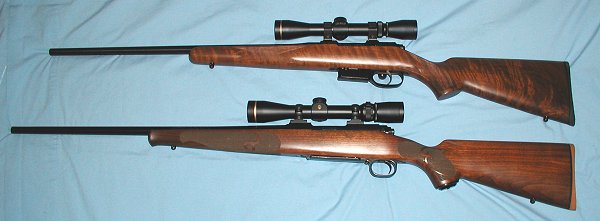
The photo below shows that you can mount the scope on the Winchester well forward of your face, even though the Winchester is wearing a bigger scope with a much larger power adjustment ring:
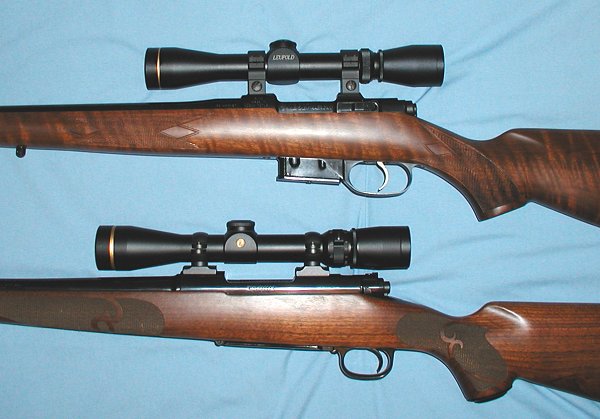
So what to do? I wasn't really happy with the 2-7X33 on the CZ because it wasn't far enough forward on the gun to give me a comfortable cheek weld as well as a good sight picture. It seems I would need another type of scope. So I started looking at the various smaller scopes on the market and I came across the Leupold M8 Fixed-Power scopes. They do not have a power adjustment ring, so that solves the problem of the power adjustment ring running up against the back scope ring. And they have another very handy feature - the adjustment turret body is offset from center - towards the rear! This would leave more room between the adjustment turret body and the front scope ring. So it looked like the Leupold fixed-power scope (in this case a 4X) would allow me to mount the scope further forward on the gun, and give me the sight picture and cheek weld I was looking for.
$219 and three days later I was in possession of a brand new Leupold M8 4X33 fixed power rifle scope. The difference between it and the 2-7X33 were obvious:
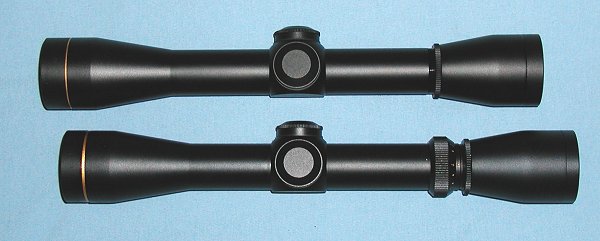
When I line up the adjustment turret bodies, which is the part that would run into the front scope ring, it is clear that the fixed power scope gives me much more room between the eyepiece and my eye. I can now move the scope forward in the rings to give a good sight picture while maintaining a good cheek weld with the stock:
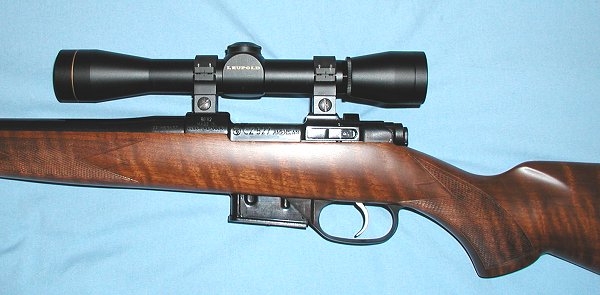
The scope is still mounted forward in the rings, but none of the parts of the scope are jammed up against the scope rings - I am now able to get a great sight picture, while achieving a rock-solid cheek weld on the stock. Man, I really like it when things finally work out!
Here is the final product:

This article by Charlie Chisholm
no7up@yahoo.com
Postscript: Think 22 Hornet is wimpy??
This swinging target was hit with a 22 Hornet 35 grain Hornady V-Max at 25 yards:
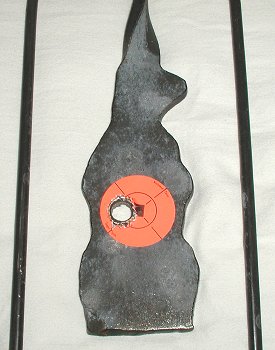
When a target says 22 rimfire only, it means it!